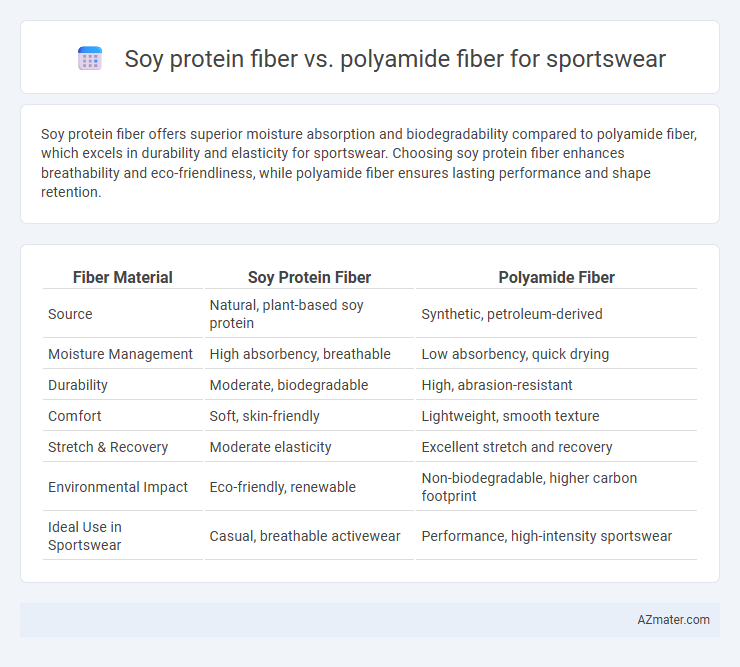Soy protein fiber offers superior moisture absorption and biodegradability compared to polyamide fiber, which excels in durability and elasticity for sportswear. Choosing soy protein fiber enhances breathability and eco-friendliness, while polyamide fiber ensures lasting performance and shape retention.
Table of Comparison
| Fiber Material | Soy Protein Fiber | Polyamide Fiber |
|---|---|---|
| Source | Natural, plant-based soy protein | Synthetic, petroleum-derived |
| Moisture Management | High absorbency, breathable | Low absorbency, quick drying |
| Durability | Moderate, biodegradable | High, abrasion-resistant |
| Comfort | Soft, skin-friendly | Lightweight, smooth texture |
| Stretch & Recovery | Moderate elasticity | Excellent stretch and recovery |
| Environmental Impact | Eco-friendly, renewable | Non-biodegradable, higher carbon footprint |
| Ideal Use in Sportswear | Casual, breathable activewear | Performance, high-intensity sportswear |
Introduction to Soy Protein Fiber and Polyamide Fiber
Soy protein fiber, derived from soybean proteins, offers excellent moisture absorption, biodegradability, and skin-friendly properties ideal for sportswear applications. Polyamide fiber, commonly known as nylon, is a synthetic polymer known for its high strength, elasticity, and abrasion resistance, ensuring durability and quick drying in activewear. Both fibers contribute unique benefits to sportswear, with soy protein fiber emphasizing comfort and sustainability, while polyamide fiber focuses on performance and longevity.
Physical Properties Comparison
Soy protein fiber offers superior moisture retention and breathability compared to polyamide fiber, making it ideal for sportswear requiring comfort and sweat management. Polyamide fiber exhibits higher tensile strength and abrasion resistance, ensuring durability and longevity under intense physical activity. Both fibers provide elasticity, but polyamide's faster drying time enhances performance in high-intensity sports environments.
Moisture Management and Breathability
Soy protein fiber exhibits superior moisture management due to its natural hydrophilic properties, efficiently absorbing and releasing sweat to keep athletes dry during intense workouts. Polyamide fiber, commonly known as nylon, offers excellent breathability with its lightweight and porous structure, promoting airflow and rapid drying. Combining soy protein fiber's moisture-wicking ability with polyamide's ventilation can enhance overall comfort and performance in sportswear.
Comfort and Skin Sensitivity
Soy protein fiber offers superior comfort for sportswear due to its natural softness and excellent breathability, making it ideal for sensitive skin and reducing irritation during intense workouts. Polyamide fiber provides durability and moisture-wicking capabilities but may cause discomfort or allergic reactions in individuals with sensitive skin due to its synthetic nature. Choosing soy protein fiber enhances skin sensitivity management while maintaining comfort in athletic apparel.
Strength and Durability
Soy protein fiber offers moderate strength and excellent moisture absorption but tends to have lower durability compared to polyamide fiber, making it less ideal for high-stress sportswear. Polyamide fiber, commonly known as nylon, exhibits superior tensile strength, abrasion resistance, and quick-drying properties, ensuring long-lasting performance and durability in rigorous athletic activities. The combination of polyamide's resilience and stretchability makes it the preferred choice for sportswear requiring sustained strength and durability over time.
Antibacterial and Odor Control Features
Soy protein fiber exhibits natural antibacterial properties due to its amino acid composition, which inhibits bacterial growth and reduces odor buildup in sportswear. Polyamide fiber, commonly known as nylon, offers durability and moisture-wicking capabilities but lacks inherent antibacterial features, often requiring chemical treatments to control odor. For optimal sportswear performance, soy protein fiber provides superior odor control through its bioactive properties, enhancing freshness during intense physical activity.
Environmental Impact and Sustainability
Soy protein fiber, derived from renewable soybean residues, offers excellent biodegradability and a lower carbon footprint compared to polyamide fiber, which is petroleum-based and contributes to microplastic pollution. Polyamide fibers, though durable and moisture-wicking, require significant fossil fuel resources and generate high greenhouse gas emissions during production. Choosing soy protein fiber for sportswear supports sustainable textile practices by reducing reliance on non-renewable resources and minimizing environmental impact through enhanced biodegradability and lower energy consumption.
Dyeability and Aesthetic Possibilities
Soy protein fiber exhibits superior dyeability compared to polyamide fiber, absorbing dyes more uniformly and resulting in richer, more vibrant colors for sportswear applications. The natural protein structure of soy fiber allows for excellent color fastness and a soft, matte finish that enhances aesthetic possibilities, providing a comfortable and stylish look. In contrast, polyamide fibers offer high color intensity and durability but tend to have a shinier surface that can limit subtle color effects and texture variations in sportswear design.
Cost-Effectiveness and Market Availability
Soy protein fiber offers a sustainable and cost-effective alternative to polyamide fiber in sportswear, benefiting from lower raw material expenses and eco-friendly production processes. Polyamide fiber, widely available in the global market, boasts high durability and moisture-wicking properties but often comes at a higher price point due to petroleum-based sourcing and complex manufacturing. Evaluating cost-effectiveness, soy protein fiber suits budget-conscious and eco-aware consumers, while polyamide remains a premium choice with extensive distribution and established supply chains.
Final Recommendation for Sportswear Applications
Soy protein fiber offers exceptional moisture absorption, biodegradability, and a soft, breathable texture ideal for sportswear that requires natural comfort and environmental sustainability. Polyamide fiber excels in durability, elasticity, and quick-drying properties, making it suitable for high-performance sportswear exposed to intense physical activity and frequent washing. For sportswear applications prioritizing eco-friendliness and skin comfort, soy protein fiber is recommended, while polyamide fiber is best for garments demanding robustness and superior moisture management.

Infographic: Soy protein fiber vs Polyamide fiber for Sportswear
 azmater.com
azmater.com